Additional notes (click to expand)
Commemorative
Sebald Justinus Brugmans (24 March 1763, Franeker – 22 July 1819, Leiden) was a Dutch botanist and physician. He was the son of naturalist Anton Brugmans (1732-1789).[1]
Brugmans studied philosophy, mathematics and physics at the Universities of Franeker and Groningen, earning his doctorate in 1781. In 1785 he became a professor at Franeker, where he taught classes in physics, astronomy, logic and metaphysics. During the following year, he succeeded David van Royen (1727–1799) as professor of botany at the University of Leiden.[2] Here, he was also served as director of the Hortus Botanicus Leiden.[3] In 1791, he transferred from the Faculty of Philosophy to that of Medicine, which from 1795 included the field of chemistry. Brugmans was very interested in the connection between chemistry and medicine.[4]
In 1794, when Holland became a refuge for retreating English and Hanoverian armies, he, along with physicians and medical students at Leiden, set up an emergency hospital services outside the city. He repeated this activity in 1799 (for English and Russian forces north of present-day IJmuiden), and in 1809 (bombardment of Vlissingen by the British Navy).
In 1795, he became in charge of the military medical service of the newly founded Batavian Republic. His outstanding work as a physician came to the attention of Louis Bonaparte, as well as to his more famous brother, who promoted him to seventh inspector-general of the Grande Armee. Later, the first king of the Netherlands, William I, restored Brugmans to his former functions, while giving him additional duties as inspector-general of the military service, the supervision of the Navy and the Colonies, of the military veterinary service, and of sanitary conditions in prisons and quarantine stations.
As a military physician, he was dedicated towards the improvement of hospital and barrack facilities. In these endeavors, he stressed the importance of cleanliness and hygiene, and strove to prevent the spread of contagious disease. He is especially remembered for his expertise in the treatment of gangrene.[4][5]
wikipedia 12-2013
Horticulture
Vigorous, semi-woody shrub or small tree 5m (15ft) high by 3m (8-10ft) wide, with ovate-oblong to narrowly elliptic, hairless or hairy, entire leaves, to 20 cm (8 inch) long. Large, solitary, pendant, tubular or trumpet-shaped, night-scented, yellow flowers with 5 reflexed, pointed lobes, 30 cm (12inch) long, are borne from early summer to autumn. A mature specimen can display as many as 80 to 100 blooms at any one time.
Brickell, C. (2003). A-Z Encyclopedia of Garden Plants. Dorling Kindersley. p.196
Sow seeds at 16°C (61°F) in spring. Root semi-ripe cuttings with bottom heat in summer. Once rooted under glass, grow in loam-based potting compost (JI No.3) in full light. From spring to autumn, water freely and apply a balanced liquid fertiliser every month; keep barely moist in winter. Outdoors, grow in fertile, moist but well-drained soil in full sun. In frost-prone areas, grow in a temperate greenhouse or conservatory over winter. Not hardy, minimum temperature 7°C/ 45°F.
Brickell, C. (2003). A-Z Encyclopedia of Garden Plants. Dorling Kindersley. p.196
Medicinal
Prescription only medicine: scopolamine
Acetylcholine antagonists- contain scopolamine, used to dilate the pupil; speed up the heart; dry up saliva and gastric secretions, and to treat organophosphorous and mushroom poisoning & motion sickness.
Oakeley, Dr. H.F. (2013). Medicines from RCP plants label list 5-2013.docx.
Nomenclature
Brugmansia-
named for Sebald Justin Brugmans (1763-1819) Professor of Natural History and Medicine, and director of the Botanical Garden at Leiden.
suaveolens-
from the Latin ‘suave’ meaning ‘sweet’ and, hence, ‘sweet-smelling’.
The trumpet-like, pendant flowers emit a delicious fragrance in the evening. Folk lore suggests that sleeping under it will bring death. However, analysis of the flowers' fragrance have not uncovered any lethal chemicals.
Oakeley, Dr. Henry F. (2013). Wellcome Library notes.
link
Other use
This is another plant within the family Solanaceae – from the Andes of South America. It is a highly
decorative, night-fragrant shrub. All parts of the plant contain high levels of scopolamine, one of the
chemicals responsible for the toxic effects of deadly nightshade, Atropa belladonna. Rubbing a flower will transfer sufficient alkaloid on to one’s fingers to dilate the pupil if one uses these fingers to rub one’s eye, and Lewis reports that sufficient can be absorbed through the skin, by rubbing with the leaves, to induce coma. The leaves or flowers are made into a tea, or smoked, and while the coma and hallucinations may last 24 hours (perhaps more), dilated pupils may persist for a week. A contractor at the Royal College of Physicians, who had spent 14 hours in a coma followed by visual hallucinations after such a tea, said nothing would induce him to try it again. Death usually occurs because the intoxicated person is left alone and falls or drowns. Italians, unable to obtain tobacco during the war, used to smoke the dried leaves, and plants may still be seen growing beside maize fields in Tuscany for this purpose. Best avoided.
Oakeley, Dr. Henry. (2011). A Year in the Medicinal Garden of the Royal College of Physicians, revised edition. Royal College of Physicians, London. page 65
link
Phytochemistry
The whole plant contains high concentrations of tropane alkaloids: hyoscine (scopolamine), apohyoscine, norhyoscine, atropine (a racemic mixture of d- and l- hyoscyamine), noratropine, and tigloyl esters. The roots contain additional alkaloids. The flowers principally contain norhyoscine (Evans & Woolley, 1969). The tropane alkaloids block the peripheral actions of acetylcholine in the parasympathetic nervous system. They block the pupillary response to bright light, speed up the heart rate, reduce salivation and sweating, reduce gut motility and inhibit the vertigo and nausea of sea sickness. Centrally they disinhibit, relax, induce hallucinations, coma and death.
Oakeley, Dr. Henry F. (2013) Wellcome Library notes.
Toxicity
Brugmansia are members of the Solanaceae family and are poisonous if eaten, especially the seeds and leaves. Although handling the plant isn't dangerous, it is advisable to wash your hands once you have finished handling the plant.
Geographical distribution
- Southern America, Brazil
- Southern America, Western South America, Bolivia
- Southern America, Western South America, Peru
Brugmansia suaveolens (Humb. & Bonpl. ex Willd.) Bercht. & J. Presl hybrid
Family: SOLANACEAEGenus: Brugmansia
Species: suaveolens (Humb. & Bonpl. ex Willd.) Bercht. & J. Presl
Cultivar: hybrid
Common names: Snowy Angel's Trumpet
Distribution summary: Brazil, Bolivia, Peru
Habit: Shrub
Hardiness: H1c - Heated greenhouse; warm temperate
Habitat: lowland to mountain forests, forest margins, savannah woodland, open grassland, shady river banks
Garden status: Currently grown
Garden location: Wolfson Terrace (T)
Flowering months: May, June, July, August
Reason for growing: Commemorative, medicinal, toxic, prescription only medicine
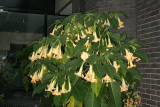

.JPG)
.JPG)
.JPG)

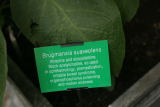
.JPG)
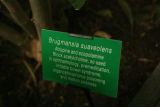
.JPG)
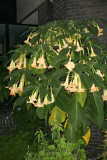
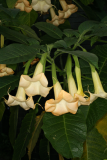
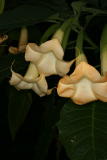
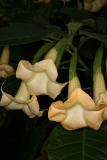
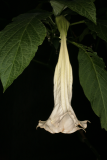
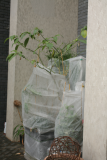
.JPG)
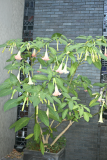
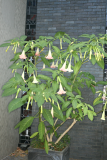

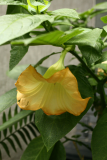
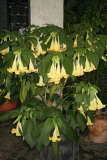
.JPG)